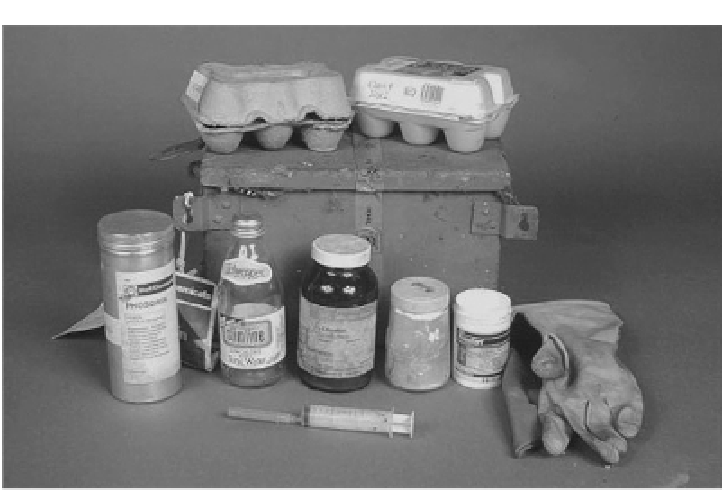Environmental Engineering Reference
In-Depth Information
Figure 6.6
A typical poisoner's toolkit recovered during a fi eld investigation (Grampian region
of Scotland)
the chemical analyses carried out by SASA reveals the use of carbofuran to deliberately kill animals,
successful prosecutions remain diffi cult to secure. For example:
1. It is rare for an offender to be 'caught in the act'.
2. The victim(s) can often be discovered several kilometres away, and in any direction relative
to the source of exposure to the poison.
3. The lethality of the chemicals involved may be disputed in court simply because they have not
been clinically tested on the species in question.
Nevertheless, various Scottish Government departments, law enforcers/prosecutors and various
stakeholders (e.g., landowners and managers, gamekeepers, non-government organisations such as
the Royal Society for the Protection of Birds (RSPB-Scotland) and the Scottish Society for the
Prevention of Cruelty to Animals (SSPCA)) are collectively committed to the detection, prosecu-
tion and ultimate eradication of all forms of crimes against wildlife. All associated activities are
vigorously encouraged and supported by many Scottish Ministers. For example, in 2007, following
a Parliamentary debate on wildlife crime, the Scottish Government announced 'A Joint Thematic
Inspection for the Arrangements in Scotland for Preventing, Investigating and Prosecuting Wildlife
Crime' (5). Scotland's Minister for the Environment also chairs meetings for the Partnership for
Action Against Wildlife Crime in Scotland (PAWS) (6,7) and in 2010, Scottish Natural Heritage
(SNH) was assigned by PAWS to administer 'The PAW Fund for Fighting Wildlife Crime' which
awards grants for new and innovative projects tackling wildlife crime in Scotland
(8).
For its part, SASA will continue to refi ne and develop analytical methodology, and exploit
advanced technology and data manipulation software to ensure that the maximum amount of evi-
dence is available for law enforcement. We have recently developed a new multi-pesticide residue
LC/MS/MS screening process that includes carbofuran and its metabolites, and which complements
our existing GC/MS/MS multi-residue method. This combination of analytical techniques signifi -
cantly increases our capability to investigate accidental and/or deliberate poisoning (9). We would
be happy to share the relevant protocols with readers of this topic and any other interested parties.




























Search WWH ::

Custom Search